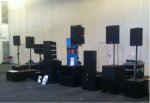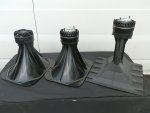Re: New DIY Mid High
FWIW I believe the system was set up by one of your representatives. I assume you have standard recommended settings for the SM80 / TH118 combination. I also think the set-up was fine, comparatively the SM80 + TH118 was very good. When you consider the total cost including amps and processors it was excellent.
My interest is in how we should voice our sound systems, particularly when setting up a system in field. I'm not talking about the amount of available sub power needed for EDM, but an alignment that sounds flat and natural and is nice to listen to.
From the description on your web page both the J1 and J2 are part of the Jericho range of speakers. They appear to designed for similar applications; to cover large spaces like a football stadium. The J1 has a 90 x 40 pattern and the J2 a 90 x 60 pattern and they both use 6 x 18" drivers for the LF. So why is there such a difference in how they are voiced?
You describe the J1 as follows "the J1-94, or Jericho Horn, is simply the most accurate high-power loudspeaker ever created” yet the low frequency between 60 – 100 Hz is about 12 dB louder than the mid band around 1000 Hz – why did you align it that way?
Of course it depends on how the systems were setup. Where were the crossover points-the delays etc? It can make a big difference on what the "perceived sound" is. It can be hard to judge a system if you are not aware of how it was setup. And maybe the person who provided the system liked the particular alignment that you heard. How the crossover is handled can make a big difference on how "disconnected" or not a sub and top cabinet are.
Regarding the J1 and J2-they are different cabinets with different intended usages. The low freq capability of the J1 is quite a bit more than any other part of the cabinet and much more than the J2. Even though they both use 6 18" drivers. The drivers are different and they way they are loaded is very different.
There are a lot of other differences and intended usages between the cabinets. For example the J2 has greater pattern control down lower and goes lower in freq naturally, but the J1 has much more impact/punch naturally down firing (stadiums where the speakers were up high was the original design idea) and so forth.
... .
FWIW I believe the system was set up by one of your representatives. I assume you have standard recommended settings for the SM80 / TH118 combination. I also think the set-up was fine, comparatively the SM80 + TH118 was very good. When you consider the total cost including amps and processors it was excellent.
My interest is in how we should voice our sound systems, particularly when setting up a system in field. I'm not talking about the amount of available sub power needed for EDM, but an alignment that sounds flat and natural and is nice to listen to.
From the description on your web page both the J1 and J2 are part of the Jericho range of speakers. They appear to designed for similar applications; to cover large spaces like a football stadium. The J1 has a 90 x 40 pattern and the J2 a 90 x 60 pattern and they both use 6 x 18" drivers for the LF. So why is there such a difference in how they are voiced?
You describe the J1 as follows "the J1-94, or Jericho Horn, is simply the most accurate high-power loudspeaker ever created” yet the low frequency between 60 – 100 Hz is about 12 dB louder than the mid band around 1000 Hz – why did you align it that way?
Attachments
Last edited:




